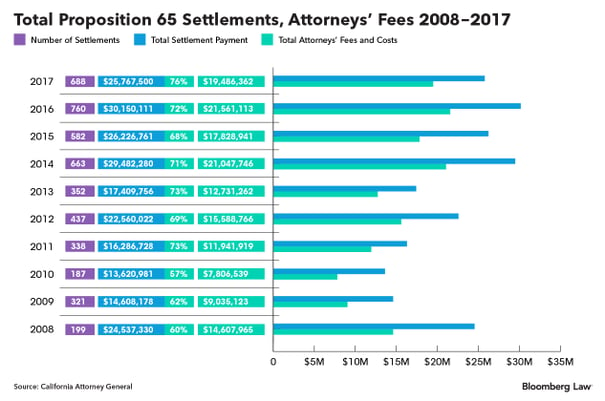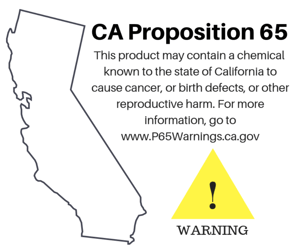Companies doing business in the US state of California need to be aware of Proposition 65, otherwise known as CA Prop 65, or, the ‘Safe Drinking Water and Toxic Enforcement Act of 1986”.
Three reasons to comply with CA Prop 65
- Financial & legal risks
- Limiting our exposure to Toxins
- Learn about your supply chain
1. Financial & legal risk
Penalties can be as high as $2,500 per violation per day. Because of this, private enforcement has become a multi-million dollar business. According to Bloomberg, “total settlement payouts have ranged from, on the low end, $13.6 million in 2010, to, on the high end, $30.1 million in 2016.”
The image below, from the Bloomberg article, shows the number of settlements, total settlement payout, and what portion of that simply went to attorney's fees.

Violations can add up fast. No business wishes to spend money on regulatory fines. So, how do you know if you need a CA Prop 65 warning label? If you have a trustworthy bill of materials for your products, screen them against the CA Prop 65 regulatory list and determine if have any substances on the list. Toxnot allows you to do this for free.
If you’re unsure about the substances in your products, Toxnot can help you fill in data gaps as well, by effectively surveying your suppliers about the chemicals they provide. If you doubt the accuracy of your bill of materials, utilize a third-party testing organization such as Intertek, to help you find out for sure. If your products do contain chemicals on the list and you’d like to actively search for safer alternatives, utilize Toxnot’s free chemical database and compare chemicals. Additionally, ChemSec provides a variety of greener alternatives.
2. Limiting our exposure to toxics
 Since its inception, the list of chemicals in Cal Prop 65 has grown to over 900.
Since its inception, the list of chemicals in Cal Prop 65 has grown to over 900.
What about the initial drive for this law? Californians were concerned about the chemicals they were being unknowingly exposed to. As a society, no one wants to be unnecessarily exposed to harmful substances.
Routinely exposing workers to harmful substances is bad for their health and welfare. An article from New Zealand showed that harmful substances kill workers at ten times the rate of accidents! Bad press associated with sick workers isn't great for business, either.
"Harmful substances kill workers at 10 times the rate of accidents"
By labeling your products accordingly, consumers can make decisions about which products they want to purchase- and you can set yourself apart by choosing safer alternatives. Workers and consumers deserve to know what chemicals they’re exposed to.
3. Learn about your supply chain
Finally, by getting a handle on the substances you’re using and their hazard profiles, you can learn more about your supply chain and chose vendors that share your safer chemistry and transparency goals. Sometimes substances leach into your products during the manufacturing process. These unknown ingredients also need to be addressed.
Beginning or enhancing your conversation with your suppliers is beneficial all around. You can take a greater position in understanding your supply chain, and become a proactive leader in your industry. Maybe getting chemicals on the CA Prop 65 list out of your products is the nudge you need to begin.
Let me know how it goes, or what you’ve already done that’s been successful.
Discover More
Interested in learning more? Read up on What is Product Compliance? You can also download our Product Compliance Trends download to get the latest insight on platforms like Toxnot can simplify your compliance management.

